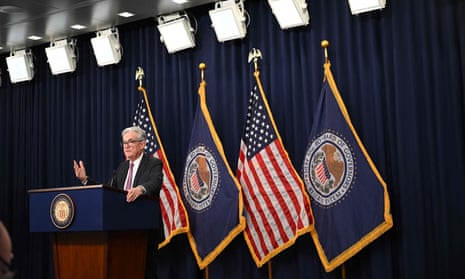Is the US in a recession? It’s a question weighing on consumers, politicians and investors around the world. Today we got one step closer to answering it. And the answer is: maybe?
How do we define recession
For many, the unofficial rule of thumb is that a recession has started after two consecutive quarters of economic contraction measured by a fall in gross domestic product (GDP) – a broad measure of the price of goods and services. In the first three months of the year GDP contracted at an annual rate of 1.6%.
Today the commerce department announced that GDP shrank again by an annual rate of 0.9% in the second quarter.
So that’s it?
Not so fast. Officially, the National Bureau of Economic Research (NBER) – a non-profit group of economists – defines when the US is in a recession.
The NBER looks at GDP but also at employment figures, personal income, industrial production and other factors. It defines a recession as “a significant decline in economic activity that is spread across the economy and lasts more than a few months”.
Federal Reserve and administration officials would also prefer the public not to think of a recession as defined purely by GDP – and presumably not to think about it at all – so they are stressing that the picture is more complicated.
Are they right?
Yes and no. Look at the jobs market. The unemployment rate is 3.6%, near a half-century low. Wages are also rising, although not as quickly as inflation, and 2.7 million people were hired in the first half of the year.
But at the same time, consumer confidence has collapsed, inflation is causing real hardship even for those with jobs, the once white-hot housing market is cooling fast in some areas, stock markets are jittery, to say the least. On top of that, you can bet that were the Republicans in power, Democrats would be calling two quarters of GDP decline a recession.
What are politicians and government officials saying?
Fed chairman Jerome Powell and treasury secretary Janet Yellen argued that inflation would be “transitory” far longer than was realistic, and they may do so again, accepting the reality of a recession. They’re both keen to promote the notion that it’s possible to cool the economy without slamming it into reverse – so-called “soft landing”.
In many ways, it’s a linguistic balancing act, with broad political consequences. On Wednesday the Fed sharply raised rates again and Powell was repeatedly asked if the US was in, or was heading towards, a recession. Powell said he didn’t believe the US was in recession but – and it’s a big but – he expects the Fed’s rate hikes to slow the economy and the job market to weaken. That’ll sure feel like a recession for some.
How unprecedented is the economic situation?
In a word, extremely. Covid disrupted the global economy in a way we have never experienced. And that disruption – much like Covid – is still with us. We have a 40-year high in high inflation, wars in important commodity-producing regions, declining real wages, slowing economic growth and a Fed that is aggressively tightening money supply after years of low rates. At the same time, the jobs market is good and consumer spending – the biggest driver of the economy – is OK, for now.
Nobel economic laureate and New York Times columnist Paul Krugman has called it “the humbug economy” – for him the numbers “don’t add up”. It may take entering a recession to figure out what is going on.
